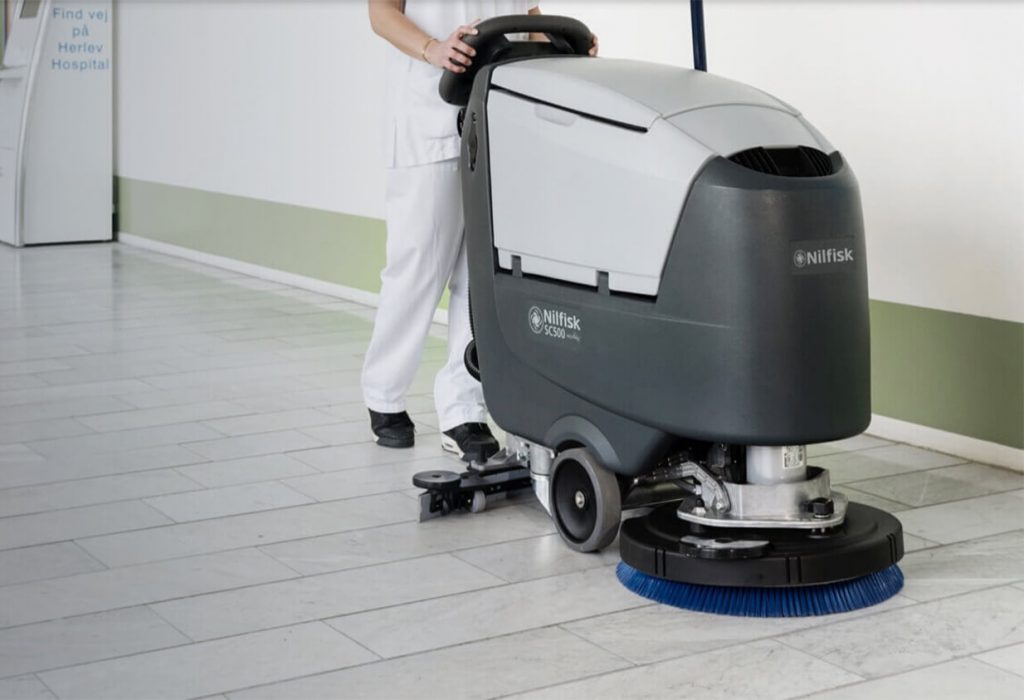Across industries and across the globe, cleaning teams are being asked to clean more surfaces, faster and more efficiently. Whether it’s sanitizing shopping carts between users, cleaning floors, or pressure washing agricultural equipment, hot water is one of the most powerful tools in your toolbox.
3 top benefits of hot water cleaning
- Efficiency — Better, faster cleaning results
- Hygiene — Reduced bacteria and virus counts
- Sustainability — Lower resource consumption
Lower resource consumption
Just like for your dishes at home, hot water cleaning provides better, faster results in commercial and industrial applications.
In partnership with the wfk – Cleaning Technology Institute, we conducted tests comparing hot and cold water pressure washing and found that across all applications, hot water reduced cleaning times by an average of 40%. In some cases, such as where greases, fats, and oils were present, hot water cleaning was four times more efficient than cold water cleaning. That translates into a cleaning time reduction of 75%.
Take a moment to think about how much more cleaning your team could get done with 40% (or 75%) more time. You might have time to clean high-use areas or equipment more often or to perform essential deep cleaning tasks.
Using hot water also reduces the drying time after cleaning, which means the areas and items you’ve cleaned are available sooner. For example, if you’re sanitizing shopping carts, hot water will help you get them back into use faster. If you’re cleaning floors, they can be reopened earlier without the risk of slips, trips, and falls.
Hygiene — Reduced bacteria and virus counts
Clean, then sanitize (or disinfect, depending on the level of clean required). This is the “one-two punch” for cleaning hard surfaces to stop the spread of germs, like viruses and bacteria, that can be harmful to human and animal health. As you likely know, the effectiveness of the second step depends, in part, on how well you’ve performed the first one.
Heat is a key factor in battling germs. A study by the Thuringen State Office for Agriculture found that, while cleaning with cold water had no impact on bacteria count, raising the temperature to 140˚F reduced the number of bacterial colonies by 90%. At 176˚F bacterial colonies were reduced by 97%, and at 311˚F they were eliminated entirely.
Heat can also help combat viruses. For example, the virus that causes COVID-19 is sensitive to heat and can be inactivated by exposure to 133°F for 30 minutes.
Hot water alone is not sufficient for sanitization or disinfection, but it can reduce the bacteria and virus counts on surfaces in preparation for the next step. Learn more from our pdf: 8 Steps to Reduce or Eliminate Germs with HOT HIGH-PRESSURE WASHERS.
Sustainability — Lower resource consumption
Finally, hot water cleaning decreases your resource consumption in three main ways.
- Water. Because hot water reduces cleaning time, less water is required. We can translate the time savings into resource savings as well — for every 264 gallons of water required for cold water cleaning, a hot water cleaner will save at least 106 gallons.
- Energy. Shorter cleaning times also mean less energy consumption.
- Chemicals. In some cases, hot water can decrease or eliminate the need for detergent because the heat is sufficient to remove the dirt. If you’re sanitizing or disinfecting, you’ll still need to use an appropriate disinfectant for this step, but you’ll still lower the overall amount of chemical you need to use.
Hot water cleaning is a highly effective way to boost the efficiency, hygiene, and sustainability of your cleaning operations. To learn about Nilfisk’s line of hot water high pressure washers go to Hydro Tek hot pressure washers, Nilfisk hot pressure washers, and Pressure-Pro hot pressure washers.
Solutions for cleaning that makes an impact
Reduce or eliminate contaminants with a combination of high temperatures and powerful chemicals.
Our pressure washers get your jobs done quickly, using less water and detergent, with high boiler efficiency and durable design. Use steaming modes for temperatures exceeding 100˚C, and a range of accessories to improve your task flexibility.
COVID-19
Supporting the people who keep the world clean
See how we’re helping cleaning professionals deliver a better, safer hygienic standard around the world.
COVID 19 supporting hygiene needs






 FREE GUIDE
FREE GUIDE











